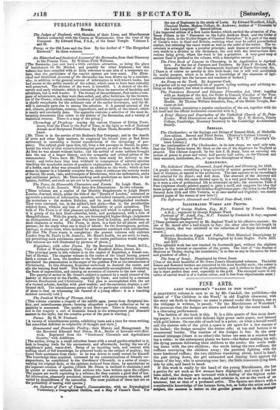FINE ARTS.
LADY WATERFORD'S "BABES IN THE WOOD."
A BEAUTIFUL volume is sent to us by Mr. Candid', the publisher,—the ballad of "The Children in the Wood," in old English character, with the story set forth in designs: no name is placed under the designs, but on the titlepage is written, in pencil, "By the Marchioness of Waterford." We presume that the designs are drawn and etched by the same hand. It is a charming performance. The fashion of the book is this. It is a thin quarto of fine stout draw- ing-paper; it is covered with delicate light green satin paper, and lettered with gold letters. On one side of each leaf is a print; on what a herald would call the sinister side of the print a space is set apart for a few stanzas of the ballad; the design occupies the dexter side; at top and bottom is an ornamental border. The number of the designs is ten. In the orna- mented titlepage (there is no other) the babes are seen at a window feed- ing a robin: in the subsequent plates we have—the father making his will; the dying parents delivering their children to the uncle; the uncle walk- ing home with the two children; the uncle hiring the two ruffians; the ruffians conveying the children away; the penitent fighting with the more hardened ruffian; the two children wandering about, hand in hand; the pair sitting down, the girl exhausted and leaning back against the breast of the boy, who is mourning over her; the little innocents lying dead, side by side, and hand in hand. If this work is really by the hand of the young Marchioness, she has a genius for art such as few women have displayed; and even if she has been aided, the designs are invented with a feeling of the highest order. We shall take the book as it stands, and criticize it, not as the work of an amateur, but as that of a professed artist. The figures are drawn with a considerable knowledge of the human form, bat, as befits the artist and the subject, the success is better in the gentler graces than in the stronger
forms and more violent action. A delicacy tending to the feeble impairs the bearded countenances of the father and uncle; the limbs and gait of the ruffians are somewhat lax and uncouth; and the skill in drawing falls short of complete mastery. But even with these defects, we observe free- dom of invention, animated conception of active movements, and indi- viduality of character. In the more graceful forms the strength of the artist comes out; for the grace is that of gentle vigour, not of weakness. Some faults in the drawing might have been mended, such as the excessive shortness of the legs here and there. But the children are noble ag well as beautiful specimens of budding humanity : they belong to the same large mould with the children of Raphael-large-limbed, full-proportioned, with ample brows. The action and the spirit of the design correspond. The action is as simple and direct as it is in the work of the Prince of Painters -there is no twisting for grace or straining for effect. The little girl, who puts her brow, with downcast eyes, against the cheek of her dying mother, and clasps the neck of the sick woman with her robust and life- some little arms, does it as simply and gracefully as a child of nature. The most complete of the designs, perhaps, is that where the wan- dering children are looking at the robin, who sits on a spray before them: the action of the two is perfectly simple; but the artist has beautifully caught those curved forms of vigorous infancy which give grace to movement-that force of expression which is given to outward action by force of character; so that with gentle innocence a certain weight and strength fill up the measure of beauty. Children of such mien and propor- tions were enjoying, strong-loving, grave-thoughted children, fitted to fulfil life in its sweetest form, fitted to be mourned by generations.
The same singleness of purpose and fulness of conception extend to the more material portions of the design. The composition is informed by the true symmetry of art. If you reject everything that is impertinent to the essence of a subject, and place all that is essential so that it shall be fully displayed, naturally ordered, yet concentrated in point of space, you will find that the result is the symmetrical composition which attained its per- fection in Raphael. The same instinct influences the artist whose work is before us. The accessories, in like manner, are sufficient without being burdensome. The robin, for example, makes no pretensions to vie with the technical illustrations of Audubon: it is too large: but there is nothing contradictory to the robin nature; there is the tame, shortneckecl, round- eyed redbreast, as it remains in the mind of childhood-the true minister- ing bird of the ballad. The same spirit of subservient fitness runs into the mere ornamental borders,-as in the one where the snakes are twining round the flower; and in the title, where a robin perches before the win- dow: the creeping plants flourish at the root, but before they grow up they wither, and the dried twig scarcely reaches a black raven that broods ominously above the children. We say that throughout this charming work there is the highest feeling of art-a thorough conception of the sub- iect, a perfect faith in the simple forms and actions of nature, and no in- considerable power of embodying the artist's idea.



























 Previous page
Previous page